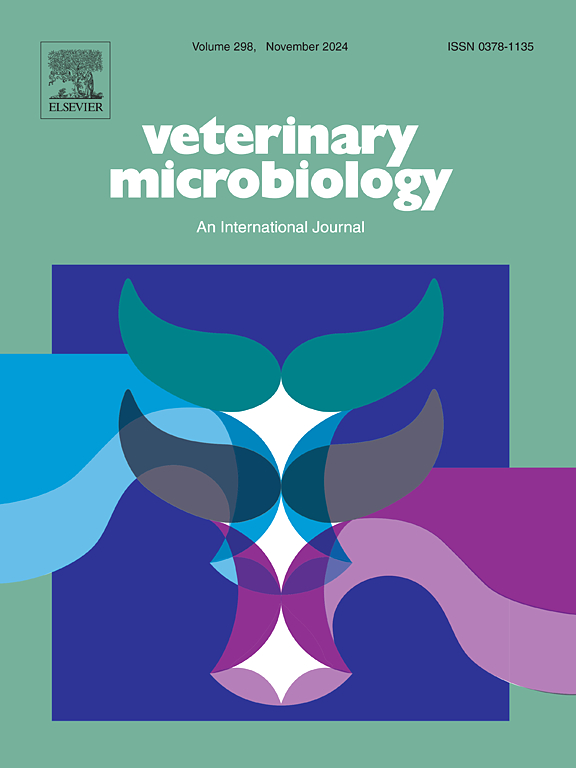针对蜱传病毒的多表位亚单位疫苗的开发和评价的方法和进展
IF 2.7
2区 农林科学
Q3 MICROBIOLOGY
引用次数: 0
摘要
蜱传病毒(TBVs)在世界范围内对公共卫生构成重大挑战,引起出血热和脑炎等严重疾病。鉴于现有治疗和预防措施的局限性,开发有效的疫苗是控制tbv相关感染的一项关键战略。本综述探讨了针对关键tbv的多表位亚单位疫苗的设计和评价的最新进展,这些tbv包括出血热病毒(如克里米亚-刚果出血热病毒、伴有血小板减少综合征的严重发热病毒)、脑炎病毒(如西尼罗河病毒、蜱传脑炎病毒)和新出现或不太常见的tbv(如版纳病毒、耶佐病毒)。重点放在应用免疫信息学和反向疫苗学鉴定表位能够诱导强大的体液和细胞免疫反应。我们总结了表位预测方法、疫苗构建设计、免疫模拟结果和分子对接发现。虽然目前的研究显示出强大的硅潜力,但我们强调迫切需要进行实验验证,以支持这些候选疫苗的临床开发。本文章由计算机程序翻译,如有差异,请以英文原文为准。
Exploring approaches and advancements in the development and evaluation of multi-epitope subunit vaccines against tick-borne viruses
Tick-borne viruses (TBVs) pose significant public health challenges worldwide, causing severe diseases such as hemorrhagic fevers and encephalitis. Given the limitations of existing therapeutic and preventive measures, the development of effective vaccines represents a critical strategy for controlling TBV-related infections. This review explores recent advancements in the design and evaluation of multi-epitope subunit vaccines targeting key TBVs, including hemorrhagic fever viruses (e.g., Crimean-Congo hemorrhagic fever virus, Severe fever with thrombocytopenia syndrome virus), encephalitis viruses (e.g., West Nile virus, Tick-Borne Encephalitis virus), and emerging or less common TBVs (e.g., Banna virus, Yezo virus). Emphasis is placed on the application of immunoinformatics and reverse vaccinology for the identification of epitopes capable of inducing robust humoral and cellular immune responses. We summarize epitope prediction methodologies, vaccine construct designs, immune simulation results, and molecular docking findings. While current studies demonstrate strong in silico potential, we underline the urgent need for experimental validation to support the clinical development of these vaccine candidates.
求助全文
通过发布文献求助,成功后即可免费获取论文全文。
去求助
来源期刊

Veterinary microbiology
农林科学-兽医学
CiteScore
5.90
自引率
6.10%
发文量
221
审稿时长
52 days
期刊介绍:
Veterinary Microbiology is concerned with microbial (bacterial, fungal, viral) diseases of domesticated vertebrate animals (livestock, companion animals, fur-bearing animals, game, poultry, fish) that supply food, other useful products or companionship. In addition, Microbial diseases of wild animals living in captivity, or as members of the feral fauna will also be considered if the infections are of interest because of their interrelation with humans (zoonoses) and/or domestic animals. Studies of antimicrobial resistance are also included, provided that the results represent a substantial advance in knowledge. Authors are strongly encouraged to read - prior to submission - the Editorials (''Scope or cope'' and ''Scope or cope II'') published previously in the journal. The Editors reserve the right to suggest submission to another journal for those papers which they feel would be more appropriate for consideration by that journal.
Original research papers of high quality and novelty on aspects of control, host response, molecular biology, pathogenesis, prevention, and treatment of microbial diseases of animals are published. Papers dealing primarily with immunology, epidemiology, molecular biology and antiviral or microbial agents will only be considered if they demonstrate a clear impact on a disease. Papers focusing solely on diagnostic techniques (such as another PCR protocol or ELISA) will not be published - focus should be on a microorganism and not on a particular technique. Papers only reporting microbial sequences, transcriptomics data, or proteomics data will not be considered unless the results represent a substantial advance in knowledge.
Drug trial papers will be considered if they have general application or significance. Papers on the identification of microorganisms will also be considered, but detailed taxonomic studies do not fall within the scope of the journal. Case reports will not be published, unless they have general application or contain novel aspects. Papers of geographically limited interest, which repeat what had been established elsewhere will not be considered. The readership of the journal is global.
 求助内容:
求助内容: 应助结果提醒方式:
应助结果提醒方式:


